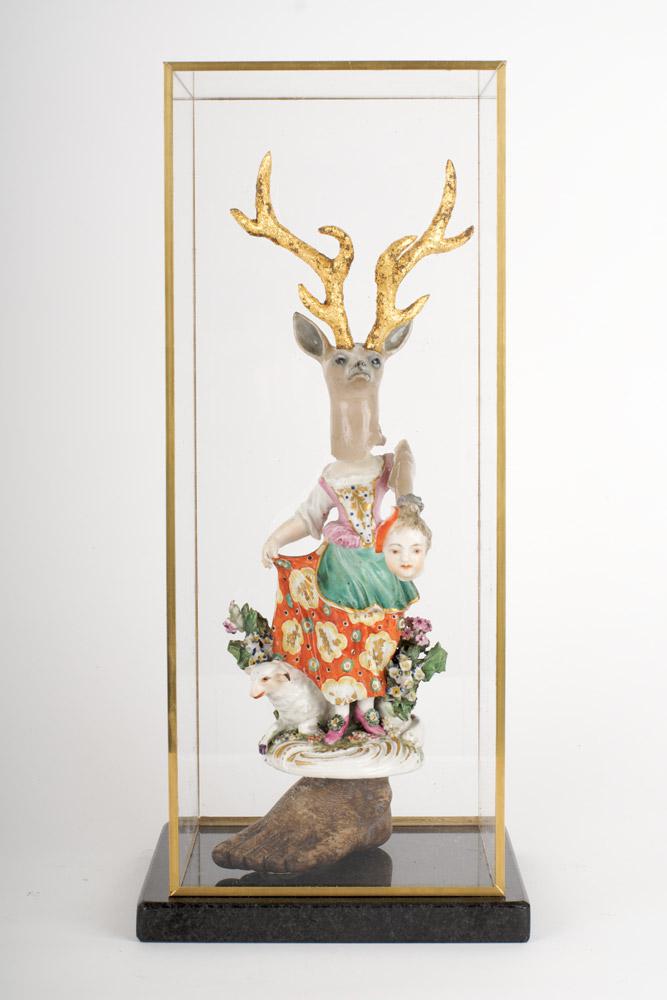In 1953, to complement the Queen’s Beasts heraldic statues that marked Queen Elizabeth II’s coronation (these now inhabit the Canadian Museum of Civilization in Gatineau) topiary versions of the creatures were completed in the extensive gardens of Hall Place in Bexley, Kent. A Tudor mansion seems an unusual setting for an exhibition of contemporary animal art, but for this history. The 60-year anniversary of the topiary beasts, which range from the lion to the unicorn, is the starting point for “Beastly Hall,” a group exhibition of 26 artists that reflects on the cultural implications of creatures both real and fantastical.
Following the French philosopher-historian Michel Foucault’s post-Nietzschean pronouncement of the “death of man,” among other recent thinkers’ dismantling of an anthropocentric worldview, interest in the animal has permeated theory and art. Curated by Dea Vanagan and Laura Culpan of the curatorial collective Artwise, “Beastly Hall” is one of a slew of recent exhibitions that explore the human relationship to other animals.
But Vanagan, who was born and raised in Vancouver and is now based in London, is keen to distinguish the exhibition from yet another animal show. She explains the guiding concept of the “artist’s beast,” which could apply literally, as in the hybrid taxidermy of Thomas Grünfeld’s Misfits series, or the proverbial beast within.
Internal struggle is invoked by two skinned-and-severed cow heads that stare one another down in Damien Hirst’s Schizophrenogenesis, which (unsurprisingly) opens the show. Hirst’s vitrines signal the modern obsession with display and the existential horror of life destroyed, dissected and isolated indefinitely for detached observation. However, it is difficult to see beyond the brand of the artist, famed for his attention-grabbing one-liners. Sacred Heart (with Hope) leaves little to the imagination, with its dagger running through a winged bull’s heart.
Other artists employ preservation in subtler ways. Grünfeld’s lamb-headed bulldog and rabbit-headed lamb are cute, cuddly and deeply disturbing. Polly Morgan’s Blue Fever further distorts specimens by reconfiguring taxidermied pigeons into a feathered orb sprouting wings. Houseflies suspended in a grid in Heart of Darkness by Claire Morgan (no relation) similarly constitute an interface of organic, decaying life and abstract geometry.
As Vanagan points out, such work is not out of place in a stately home with (bad) Victorian taxidermy stored in its attic. Mat Collishaw’s Total Recall, with its tree-stump turntables playing records of birds imitating chainsaws offers a poignant counterpart to the beautifully manicured surrounding gardens.
The interchanges and infringements of the human and animal worlds feature throughout. In Francis Alÿs’s single-channel video Night Watch, a fox set loose in London’s National Portrait Gallery brings nocturnal wildlife face to face with that paragon of high culture, the art museum. Continuing with the vulpine theme, Nina Saunders’s snarling specimen lying on a psychoanalyst’s couch suggests the start of a bad joke in Fox with Issues.
Humour and the uncanny collide in Carina Weidle’s photo series Olympic Chickens (I-XII), in which supermarket-ready carcasses perform athletic feats. The denuded fowl takes on a more sinister air in Sarah Lucas’s photograph Sex Baby, here standing in for the lower half of a female body, indicated by a cut-out tank top with protruding lemon “breasts.”
Some works scarcely portray beasts at all. Jonny Green’s monochromatic “portraits” of smoke clouds from oil fires—given eyes and named alphabetically in the tradition of hurricanes—point to anthropomorphism as an attempt to harness nature and natural disaster, even when it emerges from our own intervention.
With so many themes jostling about, the exhibition’s narrative gets lost among the beasts. Susie MacMurray’s Spectacle, a site-specific installation of wall-to-wall peacock feathers, which concludes “Beastly Hall,” introduces an entirely new set of issues. Commissioned for the exhibition, the thousands of tail feathers springing from the floor of a period room directly respond to the pageantry of the Queen’s Beasts and the procession of the coronation, but they also invoke Darwinian theory on the nature of beauty and its overlap between animals and humans.
Most work in the exhibition, contained as it is in the modern white galleries of Hall Place, remains decontextualized from the site’s history. But the striking display of MacMurray’s feathers, in tandem with the garbage-picking, shopping-cart-pushing woodland creatures that perambulate the museum’s courtyard in sculptor Laura Ford’s Rag and Bone series, truly restore the beastly to Bexley Hall.









